International
Space Band Initiative
The
Space Band concept is based on the use of inexpensive found instruments
which can be learned quickly and then used to explore the acoustic
ambience of a variety of sonic environments. Projects range from a
events which last for only a few hours, to those which include a series
of workshops followed by a mobile exploration of spaces and, perhaps,
even a concert event. In any case, the Space Band is an eye-opening and
empowering event, for both aesthetic and experiential reasons, as the
music is complex, beautiful and strikingly avant garde, and realized by
performers, usually non-muscians (children or adults), who could have
never imagine such an experience and their integral involvment.
Furthermore, participation in the Space Band has the potential of
forever changing a participant, as the mere proximity to the production
of such ethereal and beautiful sound using such a common place
instrument (made from a pot lid) invokes an acceptance of the most
experimental music. The Space Band changes people, permanently.
|
Presentations
Facebook
PNEM
Van Abbe Museum
Portland, Oregon
Prague, The Czech
Republic
Den Bosch, The Netherlands
Caldwell, Idaho
Kladno, The Czech
Republic
Hillsboro, Oregon
Muenster, Germany
Eindhoven, The Netherlands
Dommel, The Netherlands
|
       \ \ |
The
Instruments - Lydes (CDBaby)
The instruments are called lydes (lyde is the Danish word for sound)
and are simple pot lids stuck on a length of pine doweling. Most are
cast aluminum and collected from garage sales and thrift
stores in the United States.
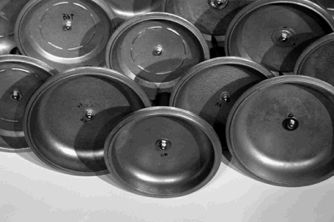
It has long been known that bell-like objects, like a
Tibetan bowls or a crystal wine glasses, will
provide a continuous ringing sound if rubbed using the right speed and
friction. For this effect using the lydes, and then also for striking
them, a
special mallet is used which is covered with leather or duct on one end
(see photo below).
A
wide variety of
percussive colors are possible with the lydes, and because they are
inexpensive found objects, it is necessary that performers accept the
uniqueness of
their pitch and timbre. Given this reality, each lyde sounds
excellently
with every other lyde and in every possible environment. There
are no wrong notes or combinations. Depending on the acoustics of a
space,
the random combination of overtones and subtones, from one to many
lydes, will mix to
buzz, gnaw and glisten in the most extraordinary ways. Players who
would
otherwise find new and experimental music difficult will most often
except these sounds as beautiful and then
participate in developing new compositions as if their prejudices had
never existed. Part of the reason for this, I believe, is that the
lydes are familiar objects and easily anthropomorphized as, say,
unwieldy and innocent children and, therefore, exempted from harsh
judgement.
Or better still, their prejudice leaves due to a nearness to the sound
and its utter physicality. But experimental new music it is and
these
instruments have great potential for opening the ears, minds and
creativity of a many.
Click
here to listen to a recording of just four lyde instruments being
performed in the continuous ringing style.
Click
here to listen to a single lyde instrument being manipulated using a
sound editor.

|
Lyde
Notation
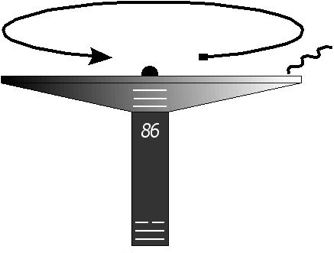
Graphic,
or
iconographic notation, differs from traditional notation in that
graphic symbols are less abstract and used to directly represent the
object being
performed. And for this reason, it does not transfer easily to other
instruments. Linear
notation, in contrast, is much better at this because of its
abstractness... but it is also complex and difficult to learn. Therefore, if you want someone to
strike the side of an object it is easiest to draw the object and a
stick hitting it.
Lyde
notation grew out of interdisciplinary workshops the composer-artist
Dan Senn organized for an innercity schools in Tacoma, Washington, in
the 1990s. To integrate the music, art, and dance areas of
the school, he taught one class to play the lydes, another
to produce graphic scores, and then both were used to accompany a new
dance piece. Then,
in 2001, for the opening of the new Glass Museum in Tacoma, Dan was
asked to produce a graphic representation of the I Ching in honor of
John Cage, for a series of museum workshops using the lyde instruments.
This resulted in
a lexicon of 64
diagrams where a system of lyde notation was more or
less formalized.
In
lyde notation,
each lycon represents one of 64 hexagrams taken from the I Ching, these
having been derived using a special
extraction system. A lycon, therefore,
represents a
kind of sonic texture which is chosen
in the same way hexagrams are traditionally
selected using the I Ching. A solution, for
example, to "what is the
best sounds for this performance environment" will result in one
or two hexagrams being selected along with the associated lycon.
Additional questions can also be put forth to produce
a complex of lycons which are then arranged as one sees fit (see image
to the right) with
those produced by moving lines kept in sequence.
In performance, one lycon is played followed by silence, then another,
and another, or lycons can be merged over
time to create complex textural mixes. The performance strategies here
are endless and may include motion (moving lycons or
moving players) to explore the acoustics of the surrounding space.
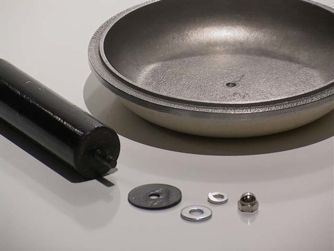
|
The Prague Initiative
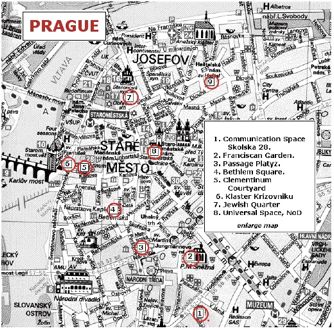
The
Prague Space Band project took place over three weeks and included a
series of advertized workshops leading to a main event. The workshops
were used to train
volunteer performers to play the lyde instruments and notation in
preparation for a Space Band event.
The
workshop artist, Dan Senn, arrived in Prague three weeks prior to
the main event and took I Ching readings at eight
stationary performance sites. At each he asked the I Ching "What sounds
will be appropriate for this
space?" Then, using traditional sticks and the I Ching, he
determined a set of hexagrams which pointed to a corresponding set of
graphic lycons—a
kind of sonic signature for that site and score for future performance.
These
symbols, a set of 3 to 4, were transferred to cloth flags in the
workshops. In the end, eight
flag-scores (see flag-score #2 below) were created for eight
performance locations each situated within "marching" distance of
one another (see map above).
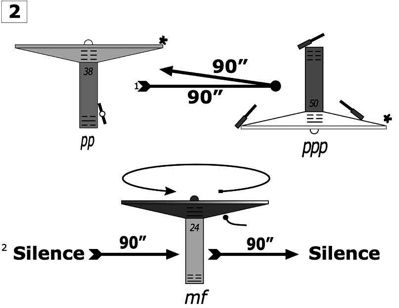
On
the day of the main performance, the Space Band gathered in the early
evening at the Skolska 28 Gallery and set off for the first stationary
performance location
while playing their instruments in the continuous ringing style. As the
musicians moved through the narrow streets, the tight cluster of
ringing sounds had the effect
of enhancing the unique
sonic characteristics of the narrow streets transfixing the band
members and those who were along the parade route. As the musicians
approached
a performance site, they slowed, gradually became silent, then still,
and began playing the score associated with that location. After a 5 to
10 minute performance, the Band set off for
the next location, again, using the continuous ringing effect.
This process repeated itself until the final location, the ninth
location, at the NoD performance space, where all flags-scores were
performed
in concert.
Click
here to see a video of the Prague Space Band Movement.
|
|

